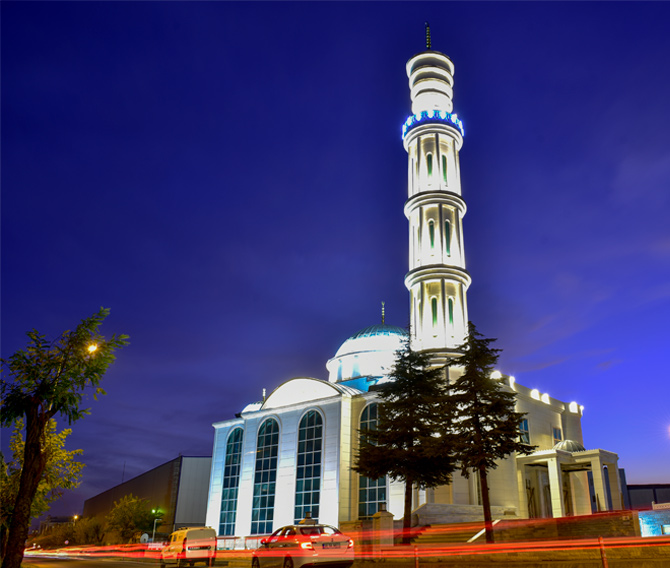
Religious buildings provide a reflective space that inspires both believers and non-believers. Twin Technology’s luminaires are seamlessly integrated into the architecture, designed to emphasize their lighting effect rather than their presence. The indirect light from wall and ceiling wash lights enhances the feeling of a safe and serene environment. Focused lighting draws attention to key elements of the space, like the altar and architectural features. Glare-free LED lighting ensures optimal visual comfort for worshippers and complements the quality of natural daylight.
When designing lighting for religious places, especially mosques, three main factors are crucial for creating a respectful, serene atmosphere while enhancing the architectural beauty.

Creating the right spiritual ambiance in a mosque is essential to fostering a sense of peace and reverence. Lighting should be soft and warm to create a calming environment that supports worship and reflection. Indirect lighting can be used to gently illuminate large spaces like prayer halls and domes, casting a subtle glow that enhances the sacred atmosphere without being overwhelming. Accent lighting on key architectural elements such as the mihrab, minbar, and intricate calligraphy helps to draw attention to these sacred features, guiding the worshippers' focus while maintaining an atmosphere of tranquility. The goal is to create a harmonious environment where light supports the spiritual experience, allowing the architecture to shine without overshadowing the reverence of the space.

Creating the right spiritual ambiance in a mosque is essential to fostering a sense of peace and reverence. Lighting should be soft and warm to create a calming environment that supports worship and reflection. Indirect lighting can be used to gently illuminate large spaces like prayer halls and domes, casting a subtle glow that enhances the sacred atmosphere without being overwhelming. Accent lighting on key architectural elements such as the mihrab, minbar, and intricate calligraphy helps to draw attention to these sacred features, guiding the worshippers' focus while maintaining an atmosphere of tranquility. The goal is to create a harmonious environment where light supports the spiritual experience, allowing the architecture to shine without overshadowing the reverence of the space.
Preserving the historical architecture of mosques is a critical consideration when designing lighting, as these spaces often feature intricate details such as calligraphy, tile work, and delicate stone carvings that must be protected from damage caused by light exposure. To maintain the integrity of these materials, low-intensity lighting is essential, ensuring that light is soft and diffused rather than harsh or direct. LED lighting is often the preferred choice due to its minimal heat emission and the ability to filter out harmful UV and infrared radiation, which can accelerate the deterioration of valuable artwork and surfaces.


Preserving the historical architecture of mosques is a critical consideration when designing lighting, as these spaces often feature intricate details such as calligraphy, tile work, and delicate stone carvings that must be protected from damage caused by light exposure. To maintain the integrity of these materials, low-intensity lighting is essential, ensuring that light is soft and diffused rather than harsh or direct. LED lighting is often the preferred choice due to its minimal heat emission and the ability to filter out harmful UV and infrared radiation, which can accelerate the deterioration of valuable artwork and surfaces.

Light, as an intangible building material, plays a symbolic role in religious structures: it is meant to represent the presence of divine forces and enhances the grandeur and significance of buildings and objects. The symbolic nature of light is influenced by its direction and the height at which the light fixtures are mounted. Light coming from above, from an unseen source, creates a mystical atmosphere, while the lower placement of floor wash lights adds an element of mysticism and drama.

Light, as an intangible building material, plays a symbolic role in religious structures: it is meant to represent the presence of divine forces and enhances the grandeur and significance of buildings and objects. The symbolic nature of light is influenced by its direction and the height at which the light fixtures are mounted. Light coming from above, from an unseen source, creates a mystical atmosphere, while the lower placement of floor wash lights adds an element of mysticism and drama.
PROJECT REFERANCES
